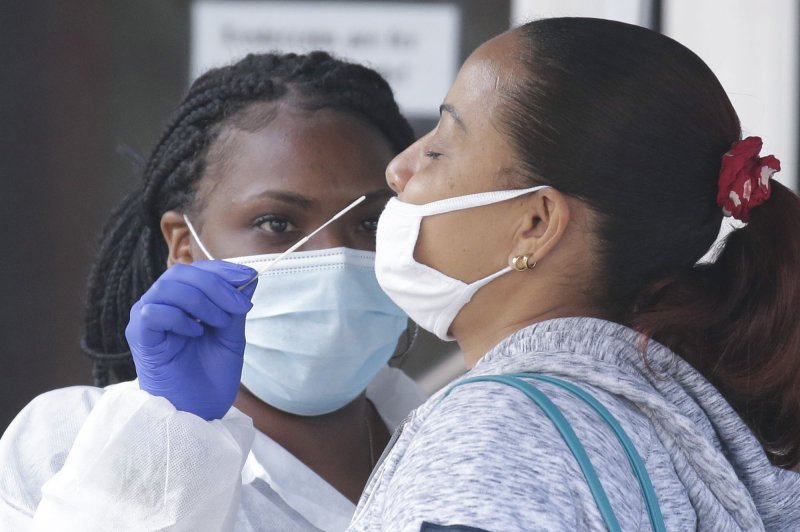
Overt and systemic racism have contributed to higher COVID-19 case rates in Black communities in the U.S. than White ones, according to new research.
File Photo by John Angelillo/UPI | License Photo
Nov. 18 (UPI) -- Overt and systemic racism may explain at least some of the elevated COVID-19 case counts in parts of the United States, according to an analysis published Wednesday by PLOS ONE.
Researchers at Texas A&M University used data from Project Implicit, a Harvard University-led reporting system for bias incidents worldwide, areas with high levels of explicit and implicit racism were more likely to have higher case numbers than others, the data showed.
The reason for this apparent relationship is that bias likely serves as a barrier preventing racial and ethnic minorities from getting access to quality healthcare, the researchers said.
As a result, many people of color and other minorities have underlying health conditions that place them at increased risk for infection and severe disease from COVID-19.
Nov. 18 (UPI) -- Overt and systemic racism may explain at least some of the elevated COVID-19 case counts in parts of the United States, according to an analysis published Wednesday by PLOS ONE.
Researchers at Texas A&M University used data from Project Implicit, a Harvard University-led reporting system for bias incidents worldwide, areas with high levels of explicit and implicit racism were more likely to have higher case numbers than others, the data showed.
The reason for this apparent relationship is that bias likely serves as a barrier preventing racial and ethnic minorities from getting access to quality healthcare, the researchers said.
As a result, many people of color and other minorities have underlying health conditions that place them at increased risk for infection and severe disease from COVID-19.
RELATED Study: Black patients get worse care after cardiac arrest
"There is a growing body of evidence that suggests racial and ethnic minorities are more affected by severe illness from COVID-19 compared to White Americans," study co-author George B. Cunningham told UPI.
"Even when taking into account the demographics and health of the county residents, we found that implicit and explicit racism contributed to COVID-19 cases ... even beyond demographic and other health measures," said Cunningham, a professor of health and kinesiology at Texas A&M University in College Station, Texas.
Black and Hispanic people in the United States are up to twice as likely as White people to experience severe COVID-19, data from the U.S. Centers for Disease Control and Prevention.
RELATED Black Hispanics at especially high risk for severe COVID-19
In addition, studies suggest that Black people and other racial and ethnic minorities are at increased risk for infection.
That people in these communities are more likely to be "essential workers," based on recent data -- meaning they still had to commute to and be at work during the pandemic -- explains some of these disparities.
People of color also are more likely to have underlying health conditions -- diabetes, heart disease and high blood pressure -- that raise their risk for severe COVID-19, according to Cunningham and his colleagues.
RELATED Black children twice as likely to die after surgery than White children
However, these trends do not tell the full story, they said.
"When we look at racial attitudes ... we are tapping into systemic forms of racism that give rise to racially biased structures and processes," Cunningham said. "These biases affect many outcomes, including religion, business, criminal justice and, in this case, health and well-being."
For the study, the researchers reviewed data on COVID-19 cases and deaths between Jan. 22 and Aug. 31 -- and information on racial attitudes reported to Project Impact -- for 817 counties across the United States.
These counties represent about 25% of all counties nationally, the researchers said.
The higher the Black population in a county, the more COVID-19 cases and deaths there, the data showed.
In addition, counties with more explicit and implicit racial attitudes had more cases of the disease, according to the researchers.
Explicit racial attitudes are "those of which people are aware and that they consciously, deliberately maintain," while implicit racial attitudes are "automatic" responses to racial and ethnic differences, the researchers said.
"Our findings contribute to the growing research base showing that racism and racial inequalities can and do affect health, and the first step is to acknowledge this reality and then, take steps to address it," Cunningham said.
"An easy place to start is for healthcare providers and professionals to participate in training and awareness programs, [while] structurally, there is a need to address access to care, quality of care and other systemic conditions that contribute to health disparities," he said.
No comments:
Post a Comment